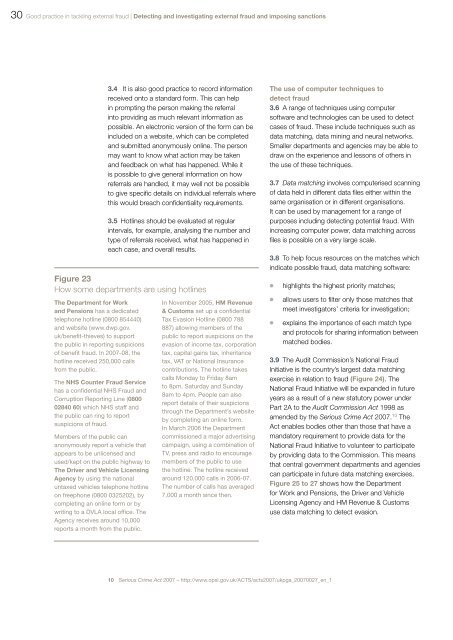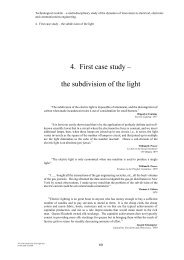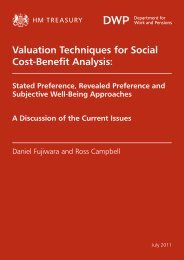NAO Good Practice Guide - Tackling external fraud - HM Treasury
NAO Good Practice Guide - Tackling external fraud - HM Treasury
NAO Good Practice Guide - Tackling external fraud - HM Treasury
You also want an ePaper? Increase the reach of your titles
YUMPU automatically turns print PDFs into web optimized ePapers that Google loves.
0 <strong>Good</strong> practice in tackling <strong>external</strong> <strong>fraud</strong> | Detecting and investigating <strong>external</strong> <strong>fraud</strong> and imposing sanctions<br />
3.4 It is also good practice to record information<br />
received onto a standard form. This can help<br />
in prompting the person making the referral<br />
into providing as much relevant information as<br />
possible. An electronic version of the form can be<br />
included on a website, which can be completed<br />
and submitted anonymously online. The person<br />
may want to know what action may be taken<br />
and feedback on what has happened. While it<br />
is possible to give general information on how<br />
referrals are handled, it may well not be possible<br />
to give specific details on individual referrals where<br />
this would breach confidentiality requirements.<br />
3.5 Hotlines should be evaluated at regular<br />
intervals, for example, analysing the number and<br />
type of referrals received, what has happened in<br />
each case, and overall results.<br />
Figure 23<br />
How some departments are using hotlines<br />
The Department for Work<br />
and Pensions has a dedicated<br />
telephone hotline (0800 854440)<br />
and website (www.dwp.gov.<br />
uk/benefit-thieves) to support<br />
the public in reporting suspicions<br />
of benefit <strong>fraud</strong>. In 2007-08, the<br />
hotline received 250,000 calls<br />
from the public.<br />
The NHS Counter Fraud Service<br />
has a confidential NHS Fraud and<br />
Corruption Reporting Line (0800<br />
02840 60) which NHS staff and<br />
the public can ring to report<br />
suspicions of <strong>fraud</strong>.<br />
Members of the public can<br />
anonymously report a vehicle that<br />
appears to be unlicensed and<br />
used/kept on the public highway to<br />
The Driver and Vehicle Licensing<br />
Agency by using the national<br />
untaxed vehicles telephone hotline<br />
on freephone (0800 0325202), by<br />
completing an online form or by<br />
writing to a DVLA local office. The<br />
Agency receives around 10,000<br />
reports a month from the public.<br />
In November 2005, <strong>HM</strong> Revenue<br />
& Customs set up a confidential<br />
Tax Evasion Hotline (0800 788<br />
887) allowing members of the<br />
public to report suspicions on the<br />
evasion of income tax, corporation<br />
tax, capital gains tax, inheritance<br />
tax, VAT or National Insurance<br />
contributions. The hotline takes<br />
calls Monday to Friday 8am<br />
to 8pm, Saturday and Sunday<br />
8am to 4pm. People can also<br />
report details of their suspicions<br />
through the Department’s website<br />
by completing an online form.<br />
In March 2006 the Department<br />
commissioned a major advertising<br />
campaign, using a combination of<br />
TV, press and radio to encourage<br />
members of the public to use<br />
the hotline. The hotline received<br />
around 120,000 calls in 2006-07.<br />
The number of calls has averaged<br />
7,000 a month since then.<br />
10 Serious Crime Act 2007 – http://www.opsi.gov.uk/ACTS/acts2007/ukpga_20070027_en_1<br />
The use of computer techniques to<br />
detect <strong>fraud</strong><br />
3.6 A range of techniques using computer<br />
software and technologies can be used to detect<br />
cases of <strong>fraud</strong>. These include techniques such as<br />
data matching, data mining and neural networks.<br />
Smaller departments and agencies may be able to<br />
draw on the experience and lessons of others in<br />
the use of these techniques.<br />
3.7 Data matching involves computerised scanning<br />
of data held in different data files either within the<br />
same organisation or in different organisations.<br />
It can be used by management for a range of<br />
purposes including detecting potential <strong>fraud</strong>. With<br />
increasing computer power, data matching across<br />
files is possible on a very large scale.<br />
3.8 To help focus resources on the matches which<br />
indicate possible <strong>fraud</strong>, data matching software:<br />
l highlights the highest priority matches;<br />
l allows users to filter only those matches that<br />
meet investigators’ criteria for investigation;<br />
l explains the importance of each match type<br />
and protocols for sharing information between<br />
matched bodies.<br />
3.9 The Audit Commission’s National Fraud<br />
Initiative is the country’s largest data matching<br />
exercise in relation to <strong>fraud</strong> (Figure 24). The<br />
National Fraud Initiative will be expanded in future<br />
years as a result of a new statutory power under<br />
Part A to the Audit Commission Act 998 as<br />
amended by the Serious Crime Act 007. 10 The<br />
Act enables bodies other than those that have a<br />
mandatory requirement to provide data for the<br />
National Fraud Initiative to volunteer to participate<br />
by providing data to the Commission. This means<br />
that central government departments and agencies<br />
can participate in future data matching exercises.<br />
Figure 25 to 27 shows how the Department<br />
for Work and Pensions, the Driver and Vehicle<br />
Licensing Agency and <strong>HM</strong> Revenue & Customs<br />
use data matching to detect evasion.





![AIRTO [Professor Dr Brian Blunden] - HM Treasury](https://img.yumpu.com/15492848/1/184x260/airto-professor-dr-brian-blunden-hm-treasury.jpg?quality=85)










